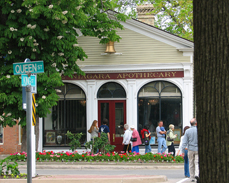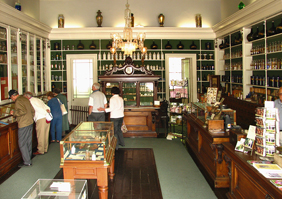
|
|
The Building
 
The Niagara Apothecary at the Sign of the Golden Mortar is an excellent example of high style, eclectic mid-Victorian commercial architecture. The Italianate fa�ade features arched glazed double doors and two arched plate glass show windows with accents of a Florentine "twisted rope" treatment.
Shown here (right) is the exterior as restored in 1971 to its 1869 opening. One of Canada's most noted restoration architects, Peter Stokes, who lived within eyesight of the Apothecary, supervised the meticulous restoration. |  |  |
 |  |
The interior (left), with its lustrous black walnut and butternut fixtures, elaborate plaster rosettes to anchor three crystal chandeliers (actually gasoliers in their time) projected an impression of 19th-century well-being and financial stability. This was especially grand for a small town in a rural setting, but it was intended by its owner to offer a boost to a community experiencing difficult financial and political problems beyond its control. |
The original interior fittings of the Apothecary, all in use for nearly a century from 1869 to 1964, have been painstakingly restored. The hub of the Apothecary was the ornately carved dispensary, which dominates the rear of the main room. With the exception of certain proprietary or patent and non-prescription remedies, even pills and other compounded medications were made in the dispensary during the 19th and early 20th century. |
|  |
The Niagara Apothecary opened its doors at its present location in 1869 (during the Canadian Confederation period). It is the only surviving building of that time in the town. (The Niagara Apothecary operated for nearly 150 years under a succession of six owners, starting about 1818/1820, at another location in town, and it closed in 1964 due to the ill health of the last pharmacist owner.)
The Ontario Heritage Trust (OHT) acquired the property from the local Niagara Foundation, led its restoration, and opened it as a museum in 1971.
The Ontario College of Pharmacists (OCP) accepted the responsibility to restore the professional practice aspects (to ensure the museum accurately reflects an operating pharmacy of the Confederation period). The College also agreed with the OHF to operate the Apothecary as a museum for an initial period of 35 years. This agreement was extended on expiry.
|
|
Shown above is the architect's drawing for the building of the Ontario College of Pharmacy (now Ontario College of Pharmacists) opened in 1887 at 44-46 Gerrard Street in Toronto. At the time it was the first structure of its kind in Canada, intended to house a pharmacy licensing body and its school. It was described by the school's first head as "a proper Aesculapian temple. A modern facade was added in the 1940s with an update of the interior. " The building served both OCP and the University of Toronto Faculty of Pharmacy well until they left the building for new homes on or near the University in 1963. The original OCP building became part of Ryerson’s campus. |
 
|
|
 |


